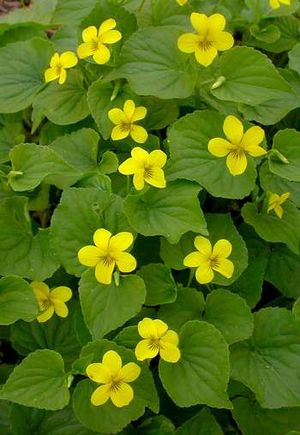Difference between revisions of "Viola glabella"
(→Description) (Tag: VisualEditor) |
|||
| Line 24: | Line 24: | ||
===Description=== | ===Description=== | ||
| − | + | Native, perennial, rhizomatous<ref name=":0">WTU | |
| − | + | ||
| − | + | ||
| − | + | ||
Herbarium, Burke Museum, & University of Washington. (n.d.). | Herbarium, Burke Museum, & University of Washington. (n.d.). | ||
| − | Retrieved from | + | Retrieved from https://biology.burke.washington.edu/herbarium/imagecollection/taxon.php?Taxon=Viola%20glabella </ref> herb with cordate leaves and axillary yellow flowers, to 30 cm tall.<ref>Bowcutt, F., & |
| − | https://biology.burke.washington.edu/herbarium/imagecollection/taxon.php?Taxon=Viola | + | Hamman, S. (2016). ''Vascular Plants of the South Sound Prairies''. Olympia: |
| − | + | The Evergreen State College Press. p. 113.</ref> Stems erect, 1-3,<ref name=":1">Jepson Herbarium Online Flora. Retrieved from https://ucjeps.berkeley.edu/eflora/eflora_display.php?tid=48214</ref> lower half leafless.<ref name=":0" /> Leaves simple, cordate, petiolate, crenate to serrate, basal leaves to 9.3 cm, cauline to 5.7 cm.<ref name=":1" /> Flowers 5-merous, solitary, axillary, zygomorphic; sepals 5, lanceolate-linear;<ref name=":1" /> petals 5, lowermost larger and spurred, upper 4 in 2 pairs;<ref name=":2" /> lower 3 petals with dark violet veins, lateral 2 bearded;<ref name=":1" /> stamens 5, connivent around pistil;<ref name=":2" /> pistil 3-carpellate with 1 style, globose stigma<ref name=":2" /> and superior ovary with parietal placentation becoming a 3-valved capsule.<ref name=":0" /> | |
| − | + | ||
===Bloom Period=== | ===Bloom Period=== | ||
| − | + | March-July <ref name=":0" /><br /> | |
| − | + | ||
| − | + | ||
===Distribution=== | ===Distribution=== | ||
| − | Both sides of the Cascades in Washington, Alaska to California, east to Montana<ref>Hitchcock, C., Cronquist, Arthur, Giblin, David, Legler, Ben, Zika, | + | Both sides of the Cascades in Washington, Alaska to California, east to Montana<ref name=":2">Hitchcock, C., Cronquist, Arthur, Giblin, David, Legler, Ben, Zika, |
Peter F., Olmstead, Richard G., . . . Porcino, Natsuko. (2018). ''Flora of the Pacific Northwest : An illustrated manual'' (Second ed.). Seattle: University of Washington Press ; Burke Museum of Natural History and Culture.</ref> | Peter F., Olmstead, Richard G., . . . Porcino, Natsuko. (2018). ''Flora of the Pacific Northwest : An illustrated manual'' (Second ed.). Seattle: University of Washington Press ; Burke Museum of Natural History and Culture.</ref> | ||
===Habitat=== | ===Habitat=== | ||
| − | + | Stream banks and moist forests, low to mid-elevations.<ref name=":0" /> | |
===Propagation=== | ===Propagation=== | ||
Latest revision as of 15:54, 30 June 2021
- Scientific Name: Viola glabella
- Family: Violaceae
- Common Names: stream violet, yellow wood violet, pioneer violet
- Codon: VIOGLA
Contents
Taxonomy
| Scientific classification | |
|---|---|
| Kingdom: | Plantae |
| Subkingdom: | Viridiplantae |
| Phylum: | Tracheophyta |
| Subphylum: | Spermatophytina |
| Class: | Magnoliopsida |
| Subclass: | Rosanae |
| Order: | Malpighiales |
| Family: | Violaceae |
| Genus: | Viola L. |
| Species: | Viola Glabella Nutt. |
Description
Native, perennial, rhizomatous[2] herb with cordate leaves and axillary yellow flowers, to 30 cm tall.[3] Stems erect, 1-3,[4] lower half leafless.[2] Leaves simple, cordate, petiolate, crenate to serrate, basal leaves to 9.3 cm, cauline to 5.7 cm.[4] Flowers 5-merous, solitary, axillary, zygomorphic; sepals 5, lanceolate-linear;[4] petals 5, lowermost larger and spurred, upper 4 in 2 pairs;[5] lower 3 petals with dark violet veins, lateral 2 bearded;[4] stamens 5, connivent around pistil;[5] pistil 3-carpellate with 1 style, globose stigma[5] and superior ovary with parietal placentation becoming a 3-valved capsule.[2]
Bloom Period
March-July [2]
Distribution
Both sides of the Cascades in Washington, Alaska to California, east to Montana[5]
Habitat
Stream banks and moist forests, low to mid-elevations.[2]
Propagation
Stream violet is easy to establish in woodland gardens. It may reseed and can become somewhat weedy.
Photo Gallery
References
- ↑ Integrated Taxonomic Information System. Retrieved from https://www.itis.gov/servlet/SingleRpt/SingleRpt?search_topic=TSN&search_value=22082#null
- ↑ 2.0 2.1 2.2 2.3 2.4 WTU Herbarium, Burke Museum, & University of Washington. (n.d.). Retrieved from https://biology.burke.washington.edu/herbarium/imagecollection/taxon.php?Taxon=Viola%20glabella
- ↑ Bowcutt, F., & Hamman, S. (2016). Vascular Plants of the South Sound Prairies. Olympia: The Evergreen State College Press. p. 113.
- ↑ 4.0 4.1 4.2 4.3 Jepson Herbarium Online Flora. Retrieved from https://ucjeps.berkeley.edu/eflora/eflora_display.php?tid=48214
- ↑ 5.0 5.1 5.2 5.3 Hitchcock, C., Cronquist, Arthur, Giblin, David, Legler, Ben, Zika, Peter F., Olmstead, Richard G., . . . Porcino, Natsuko. (2018). Flora of the Pacific Northwest : An illustrated manual (Second ed.). Seattle: University of Washington Press ; Burke Museum of Natural History and Culture.


